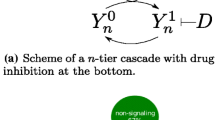Abstract
Many interacting biomolecular components in cells form different positive or negative feedback loops. When biological signals transduce through cascades consisting of various loops they will be affected or even distorted. Especially, how to process various signals buried in various intrinsic and extrinsic noises is an important issue. This paper analyzes how the response time influences noise filtering ability and how to enhance the ability by coupling different feedback loops. A parameter to measure the response time of the signal transduction, i.e., τ 0.9, and its relationship between the response time and noise filtering will be discussed. The authors show clearly that the longer the response time is, the better the ability to filter noises will be. Therefore, to enhance the ability to filter noises, the authors can prolong the response time by coupling different positive or negative feedback loops. The results provide a possible approach to enhance the ability to filter noises in larger biomolecular networks.
Similar content being viewed by others
References
C. Gomez-Uribe, G. C. Verghese, and L. A. Mirny, Operating regimes of signaling cycles: Statics, dynamics, and noise filtering, PLoS Comput. Biol, 2007, 3(12): 246.
R. Wang, L. Chen, and K. Aihara, Construction of genetic oscillators withe interlocked feedback networks, J. Theor. Biol, 2006, 242: 454–463.
R. Wang, L. Chen, and K. Aihara, Detection of cellular rhythms and global stability within interlocked feedback systems, Mathematical Bioscience, 2007, 209: 171–189.
T. Shibata and K. Fujimoto, Noisy signal amplification in ultrasensitive signal transduction, Proc. Natl. Acad. Sci, 2005, 102: 331–336.
G. Hornung and N. Barkai, Noise propagation and signaling sensitivity in biological networks: A role for positive feedback, PLoS Comput. Biol, 2008, 4(1): e8.
D. Angeli, J. Ferrell, and E. Sontag, Detection of multistability, bifurcations, and hysteresis in a large class of biological positive-feedback systems, Proc. Natl. Acad. Sci, 2004, 101: 1822–1827.
T. Shibata and M. Ueda, Noise generation amplification and propagation signaling in chemotactic systems of living cells, BioSystems, 2008, 93: 126–132.
M. R. Bennett, D. Volfson, L. Tsimring, and J. Jeff Hasty, Transient dynamics of genetic regulatory networks, Biophys. J., 2007, 92: 3501–3512.
J. R. Kim, Y. Yoon, and K. H. Cho, Coupled feedback loops form dynamic motifsof cellular networks, Biophys. J., 2008, 94: 359–365.
J. Saez-Rodriguez, A. Kremling, H. Conzelmann, et al., Modular analysis of signal transduction networks, IEEE Contr. Syst. Mag., 2004, 24(4): 35–52.
T. Yanagida, M. Ueda, T. Murata, S. Esaki, and Y. Ishii, Brownian motion, fluctuation and life, Biosystems, 2007, 88: 228–242.
Author information
Authors and Affiliations
Corresponding author
Additional information
This research is supported by the National Natural Science Foundation of China under Grant No. 10832006, Youth Research under Grant No. 10701052, and Shanghai Pujiang Program.
Rights and permissions
About this article
Cite this article
Liu, D., Chang, X., Liu, Z. et al. The effect of coupled feedback on noise filtering in signal transduction networks. J Syst Sci Complex 23, 942–950 (2010). https://doi.org/10.1007/s11424-010-0209-9
Received:
Revised:
Published:
Issue Date:
DOI: https://doi.org/10.1007/s11424-010-0209-9




